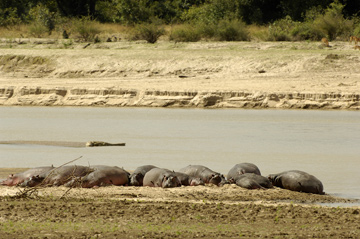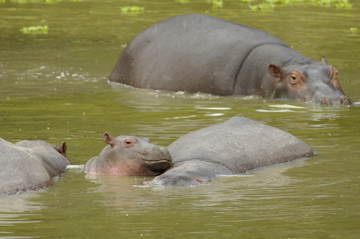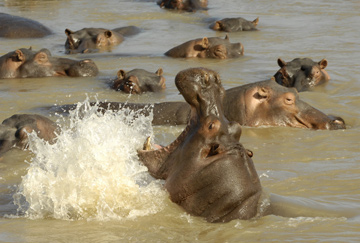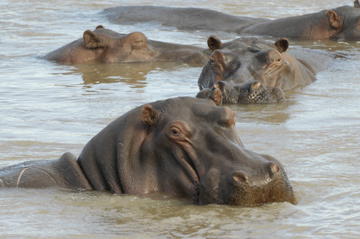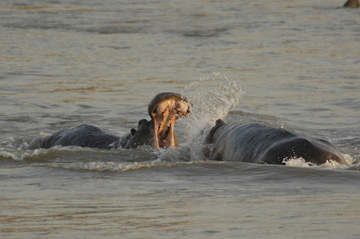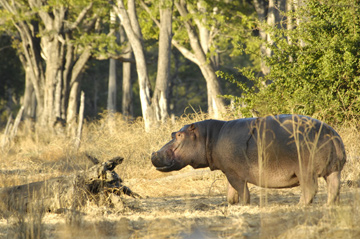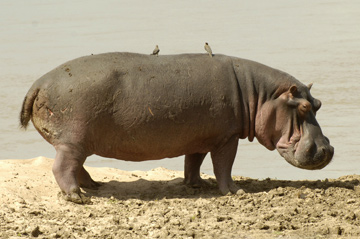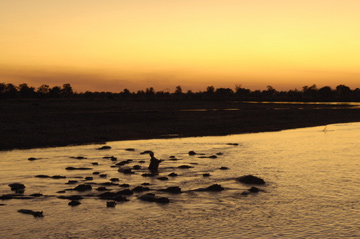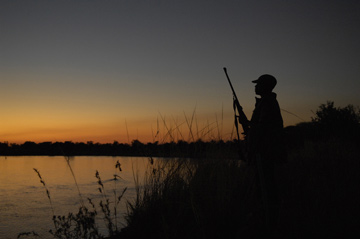Photos: ‘River horses’ threatened in Africa
Photos: ‘River horses’ threatened in Africa
Julie Larsen Maher, special to mongabay.com
January 7, 2008
A hippo photo safari by Julie Larsen Maher of the Wildlife Conservation Society
As the sun sets on the Luangwa River in Zambia, a male hippo throws its mouth open in a yawn as wide as a canyon. Night is falling as the hippo herds break to the banks to follow their regular paths to their feeding grounds. Their huge, round hooves made muddy imprints during the rainy season, and have dried to concrete craters along a trail the hippos follow to graze in grassy glades.
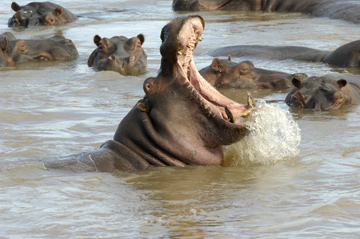
All photos by Julie Larsen Maher, ©WCS. |
Hippopotamuses, derived from the Greek words “river horse”, are semi-aquatic herbivores that live their lives in water, except for evening feeding rituals. Zambia, in East Africa, is one of their few remaining strongholds. More hippos live in Zambia than any other country, with over half of the estimated 40,000 living in the fresh waters of the Luangwa Valley.
Hippos are low-slung with big bellies giving them the appearance of being awkward on land, but they are fast runners and can cover great distances when defending their territory or searching for food.
Male hippos take over a length of riverbank to establish mating territories. Sometimes these squatting rights result in fierce fights where the males bellow loudly and bare their huge canine teeth.
Despite their reputation for bad tempers, hippos are threatened themselves. Illegal and unregulated hunting for hippo meat and teeth (which are a source of ivory for export) have landed one of the world’s largest land mammals on the 2007 IUCN Redlist of Threatened Species with “Vulnerable” status.
Hippos rely on fresh water habitats, which puts them at odds with humans who have growing needs for the same. Above the Luangwa Valley on the plateau watersheds, more and more land is being cleared for people to plant crops like cotton and tobacco, which results in runoff downriver that is silting up the Luangwa River and shrinking waterholes for Africa’s largest remaining hippo population. Competition for water and food, and crop raiding by wild animals, including hippos, threatens food security for many households.
The Wildlife Conservation Society’s Dale Lewis, the country director for Zambia, has established COMACO (Community Markets for Conservation) in response to these challenges. WCS has targeted conservation of hippos and other wildlife in Zambia through this program, where one-time poachers, who were diminishing animal populations including hippos and elephants, receive training in organic farming, carpentry, bee-keeping, and ecotourism. The implementation of COMACO methods by local people reduces conflicts with wildlife, thus building a more hopeful future for Africa’s wild animals.
Meanwhile, just north of Zambia in southern Tanzania, hippos are facing similar problems in sourcing fresh water. The Great Ruaha, once a vast and permanent river that drains ultimately into the Indian Ocean, has been slowly drying up inside Ruaha National Park. This has been due to large-scale rice irrigation schemes taking water up-stream, but not replacing it. The situation has become so bad that the river now stops completely for two months a year and the hippos are seriously threatened.
“We are working with national parks and rice cooperatives to try and reduce illegal water withdrawal,” says WCS Tanzania Country Director, Tim Davenport. “Meanwhile, we are closely monitoring the 900 or so hippos to try and ensure that they survive until the Great Ruaha flows all year round once more.”
There are just over 100 hippos at 41 North American institutions in Canada, the United States, and Mexico.
Related articles
Conserving wildlife in Tanzania, Africa’s most biodiverse country: An interview with Tim Davenport
With ecosystems ranging from Lake Tanganyika to Mt. Kilimanjaro, Tanzania is the most biodiverse country in Africa. Though Tanzania is world famous for its safari animals, the country is also home to two major biodiversity hotspots: the Eastern Arc Mountains and the Albertine Rift surrounding Lake Tanganyika. Tanzania has set aside nearly a quarter of its land mass in a network of protected areas and more than one-sixth of the country’s income is derived from tourism, much of which comes from nature-oriented travel.
Agents of death for wildlife become jewelry in Zambia
Craftswomen in Zambia are turning snares formerly used to illegal kill wildlife into jewelry. Called “snareware”, the handmade jewelry is part of a program that has grossed $350,000 for rural communities and helped protect endangered wildlife. The program, known as COMACO (Community Markets for Conservation), is a farming co-op designed by the New York-based Wildlife Conservation Society (WCS) in Zambia’s rural Luangwa Valley. It allows poachers to trade firearms and snares for training in organic farming methods, bee-keeping, gardening, carpentry, and jewelry making. WCS says over 40,000 snares and 800 firearms have been turned in to date.
When elephants attack. Surviving an elephant charge in the Congo rainforest of Gabon
We are in the rainforest of Loango National Park in the Central African country of Gabon.The five of us–local guides, Patrick and Ghislan; Flip, a veteran safari guide from Zimbabwe; Francesco, a fellow traveler from Italy; and myself–have quietly approached a family of forest elephants: a bull, a cow, and her calf. Slightly smaller than their more familiar relative, the savanna elephant, forest elephants are generally shy animals confined to the dark recesses of tropical forests in West and Central Africa. Here in Loango, where forest is interspersed with savanna, these pachyderms sometimes appear in plain sight as they move across grassy zones and swampy meadows. However, at the first hint of danger, they move back into the protective cover of the forest where they blend surprisingly well into the shadows.
